7.66. Calculate the pH of the resultant mixtures:
a) 10 mL of 0.2M Ca(OH)2 + 25 mL of 0.1M HCl
b) 10 mL of 0.01M H2SO4 + 10 mL of 0.01M Ca(OH)2
c) 10 mL of 0.1M H2SO4 + 10 mL of 0.1M KOH
7.66. Calculate the pH of the resultant mixtures:
a) 10 mL of 0.2M Ca(OH)2 + 25 mL of 0.1M HCl
b) 10 mL of 0.01M H2SO4 + 10 mL of 0.01M Ca(OH)2
c) 10 mL of 0.1M H2SO4 + 10 mL of 0.1M KOH
-
1 Answer
-
(a) Total number of moles present in 10 mL of 0.2 M calcium hydroxide are (10×0.2) / 1000? = 0.002 moles.
Total number of moles present in 25 mL of 0.1 M HCl are (25×2) / 1000? = 0.0025 moles.Ca (OH)2? + 2HCl → CaCl2? + 2H2? O
1 mole of calcium hydroxide reacts with 2 moles of HCl.
0.0025 moles of HCl will react with 0.00125 moles of calcium hydroxide.
Total number of moles of calcium hydroxide unreacted are 0.002−0.00125 = 0.00075 moles.
Total volume of the solution is 10 + 25 = 35 mL.
The molarity of the solution is (0.00075×1000) / 35? = 0.0214M
[OH−] = 2 × 0.0214...more
Similar Questions for you
0.01 M NaOH,
M = 1 * 10-2

pOH = 2
pH = 2
Kp = Kc (RT)Dng
36 * 10–2 = Kc (0.0821 * 300)–1
Kc = 0.36 * 0.0821 * 300 = 8.86 » 9
A(g) ->B(g) + (g)
Initial moles n 0 0
Eqb. moles n(1 – a) na
total moles =
Eqb. pressure
On increasing pressure, equilibrium moves in that direction where number of gaseous moles decreases.
Taking an Exam? Selecting a College?
Get authentic answers from experts, students and alumni that you won't find anywhere else
Sign Up on ShikshaOn Shiksha, get access to
- 65k Colleges
- 1.2k Exams
- 679k Reviews
- 1800k Answers


